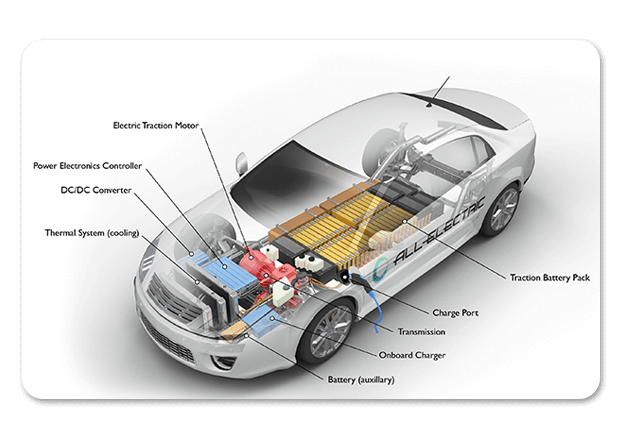

Before understanding how an EV works, you need to understand what an EV is, and what is its construction. EV is an abbreviation for Electric Vehicles, which means vehicles, where the primary source of energy is electricity. Now, to run a car with electricity, or a car in general, you need the wheels to spin. Now one device we know, that can convert electrical energy into mechanical energy is a motor. So with the combination of voltage and a motor, the EV's are run. Now as simple as it sounds, it is far more complicated in implementations. There are a lot of operations to be performed simultaneously, all of which are being run on electricity.
Now since everything runs on electricity, you need a voltage source. In this case, a battery is used. It is just like the fuel tank for any other conventional IC engine, however, instead of petroleum, the fuel here is voltage. And since the car needs to perform a lot of electrical tasks, the batteries need to be sufficient to power all these, without any difficulties. For that purpose, the batteries of an EV are made of Lithium-ion or Li-on or Lithium-Sulphur, or Li-S. these batteries can carry up to 30-40 kWh of energy for a midsize EV. however, Tesla boasts a massive battery pack of 60-100 kWh in its luxury variants.


Now that you have a large battery to perform several operations, the energy will get expended. Hence, coming to charging. The charging of an EV is just like charging any other appliance except it needs a much faster charging rate. Tesla offers about 500kW/h of charging rates at its superchargers, which are practically free for Tesla owners. However, if you own an EV or plan to buy an EV from any other manufacturer, you need to get a wall kit, in your home to charge your car. There are two types of chargers, one of the alternate current charging and the other one is the direct current charging. When doing it from home, you would have to install an A.C charging device to fill your EV up.
A lot of people are concerned with the use of EV's freely on-road and the dependence on computers inside them to guide them through roads. However, there are multiple tests done on every electrical component before its brought on the road. Also, the autopilot feature that a lot of leading EV manufacturer boasts also has limited usage in practical scenarios and hence there is no actual threat of using EV's amidst the general traffic.
Now coming to the most important part of an EV, the powertrain. Like gasoline cars have engines, the EV's have one or multiple electric motors. Now there are several motor types available. The Tesla Model 3 uses the permanent magnet DC motor to run on the roads, also a lot of manufacturers use induction motors as well. The motors mostly run on alternating current, but some manufacturers make them with DC motors as well. Apart from the engine, there is an automatic transmission box and regenerative braking in almost every EV. regenerative braking charges the battery, wven while braking or where the acceleration pedal is not being used, to give the car an extra mile or two of range.